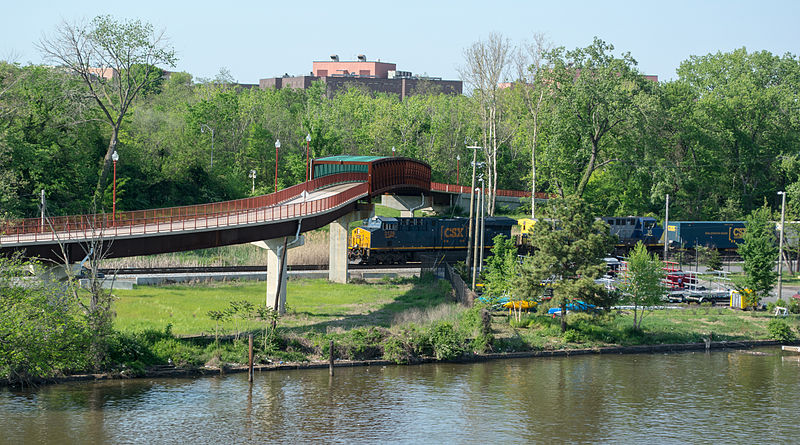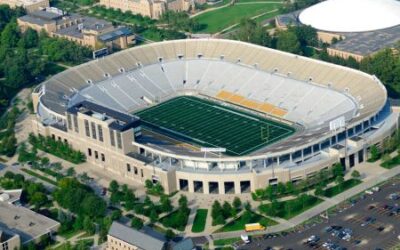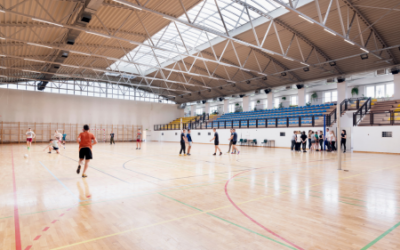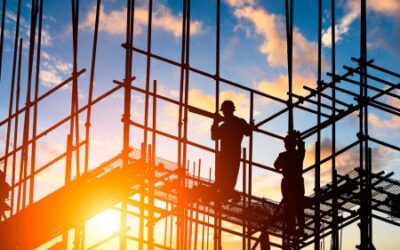The most notable recent news in American infrastructure broke last week when the U.S. Department of Transportation announced $1.8 billion in new funding for 148 infrastructure projects. My previous column covered many of the projects already selected for that funding. Today’s column focuses on more projects chosen for this new funding.
The upcoming projects described in today’s column are located in different states. They are not just new but monumental in scale. Solicitations for private sector contractors will not be released for months, so interested companies have ample time to vet the opportunities and get positioned to compete for the work. The initiatives are large, and most will consolidate other funding with this recent federal support. Because the funding amount is so large, projects are divided into categories. This column will cover projects selected for support in the bridge and multimodal category.
Most new bridge structures today are designed to accommodate non-motorized traffic and include cutting-edge technology, new signage, lighting, trail connections and other enhancements. This results in a need for a diverse range of contractors, from construction to technology, making these projects inclusive and full of opportunities.
Officials in Sharpsburg, Pennsylvania, received $24.9 million to support a project to connect the Allegheny Riverfront to an economic development initiative. The objective will be to improve alternative transportation options and connect waterfront sites to the surrounding communities to accommodate future redevelopment. A 300-foot multimodal bridge over the impassable Conemaugh rail line will be constructed to connect sidewalks and pedestrian rail crossings. It will also include a new roadway that connects surrounding communities to the riverfront. A multi-use bike and pedestrian trail will be built along the riverfront, and improvements will be made to six bus stops along a major roadway.
Once the project is complete, development of 52 acres of waterfront brownfields will be available for development. The new connections will allow the construction of affordable housing, transportation options, attractive greenways, retail and economic opportunities for residents. The project will improve safety conditions for citizens and also support the goal of carbon neutrality by 2050. Construction will likely be postponed until 2027.
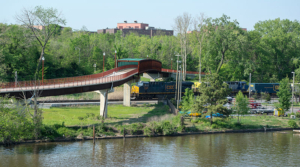
A train passing beneath a pedestrian footbridge on the Anacostia Riverwalk Trail in Washington, D.C.
Photo by Tim Evanson
Department of Transportation officials in Washington, D.C., will begin preparations for a $35 million infrastructure project designed to increase connectivity across the Anacostia River after receiving $25 million in funding support. The New York Avenue Bridge and Lincoln Connector Trail project will provide various types of transportation connections across the Anacostia River. The work will also rehabilitate the current New York Avenue Bridge to fix erosion issues and improve freight connections. Protective materials will be added to stop erosion, repair concrete supporting piers and stabilize metal railings.
The bridge will add new bicycle and pedestrian space to accommodate connections to the rest of the D.C. bikeway network and provide convenient access to the greater D.C. area. The project is in the design phase, and officials hope to move to construction by late 2025 or early 2026.
The Oklahoma Department of Transportation will execute a $21.7 million bridge project in downtown Oklahoma City. The project will construct a multimodal bridge alongside the Interstate 35 river crossing on the city’s east side. Design plans will likely have the bridge connect to an L-shaped area on the west side of the interstate bridge to allow connections to newly built riverside trails.
This new bridge will improve safety for cyclists and pedestrians by keeping them away from the interstate. The new connections between the south bank and the downtown area will provide more travel options and enhanced convenience. Solicitation documents for this project are expected in 2026.
Officials in Seattle have announced a large project that will complete the last remaining gap of a 26-mile Eastrail Bike Path that provides connections to the city’s suburbs. Since work on the trail began in 2017, more than $260 million has already been invested. This last effort carries a cost projection of $41.9 million. It will retrofit a steel rail bridge that crosses over 16 lanes of Interstate 90 to close the 1.7-mile gap in the trail.
The bridge will have graded paths leading up to and away from the overpass. Suitable lighting, wayfinding technology and secure railing will enhance the safety of the trail. It will not only provide safe travel for pedestrians, bicyclists and wildlife, but it will also deliver environmental sustainability and community connectivity. The project is currently in the design phase and will be followed by pre-construction activities, including a wastewater project that must be completed before constructing the I-90 overpass. Because of that, private sector contractors should know that procurement activities will be delayed for an extended period of time.
The Hawthorne Avenue Pedestrian and Bicycle Bridge project in Bend, Oregon, is moving through a design phase with community input occurring this month after receiving $20 million from the latest infrastructure funding allocations. The bridge will provide a safe crossing over Interstate 97 and the Burlington Northern and Santa Fe Railway and connect a residential area to downtown. The bridge, which will comply with the Americans with Disabilities Act, will provide room for pedestrians and bicyclists without hindering the traffic below. All decisions have yet to be made on the type of bridge structure that will be used. Planners, however, are considering options that include a cable-stayed bridge, an extra-dosed bridge or a truss bridge. The total project cost will depend on which bridge type is selected, but the effort currently carries a projected cost between $27 million and $42 million. Design work will begin in 2025, and construction will be underway by 2026. An open house event with more details about the project is planned for July 10.
More project funding support for upcoming projects will be outlined in future columns, so stay tuned.

